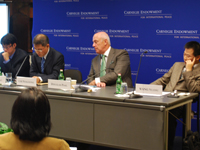Registration
Thank you!
You will receive an email confirming your registration.
IMGXYZ3276IMGZYXPresident Obama will spend more than a week in the Pacific this November, hosting the APEC leaders meeting and attending the East Asian Summit for the first time. The interaction with China will be among the main events in this high visibility effort by the United States to “rebalance” its attention to Asia.
CAI Penghong, LI Wentao, and WANG Yuzhu, visiting experts from China, joined Carnegie's Douglas Paal to review the prospects for this interaction.
Regional Economic Dynamics
- Profusion of Free Trade Agreements (FTAs): In the 20 years since China joined APEC, there has been a profusion of free trade agreements among countries within the region, matched by a trend towards regionalism, Cai said.
- Problems Facing Integration: Li pointed out that Asia Pacific regional economic integration is problematic for a number of reasons, including competition between different Regional Trade Agreements (RTA) FTAs, disagreement over regional leadership roles, and too many competing conceptions of what a regional economic grouping might look like.
- Different Approaches: Li explained that different powers in the region back different approaches to economic integration:
- ASEAN uses the ASEAN+1 format as a way to balance regional powers.
- China prefers the ASEAN+3 format.
- Japan, however, prefers the ASEAN+6 format, which includes other countries and discusses security and strategic issues.
- An East Asian Community: In 2009, Japanese Prime Minister Hatoyama spoke out in favor of the creation of what he called an “East Asian Community.” China’s response at the time was unenthusiastic. Wang argued China’s President Hu Jintao did not respond to Hatoyama at that time because China was unprepared for the comment; he did not think the lack of response indicated a calculated strategy by Beijing. Vice-President Xi Jinping has since spoken favorably about the idea, but China’s main target remains domestic economic growth, Wang pointed out.
The Future of APEC
- APEC’s Future Options: Cai cautioned that APEC’s future success ultimately depends on enacting binding reforms. He described four different possible regional economic forms:
- Free trade network: A network of bilateral and multilateral FTAs could be implemented. Such a network would be comprehensive but overlapping.
- Free trade hub: A major leading free trade agreement group would play the role of a hub for the region.
- Trade liberalization: Lowering trade barriers in the region.
- The Trans-Pacific Partnership (TPP): A regional trade agreement proposed by the U.S. between the U.S. and eight countries, not including China.
- Inadequate Mechanisms for Integration: Li pointed out that regional economic integration through existing mechanisms would bring complexity and uncertainty to the future regional environment. For example, creating a new regional approach through the TPP or an ASEAN+3 grouping would be hard to develop consensus around, Li argued.
- More Effective APEC: APEC’s approach emphasizes diversity, which Li argued makes it an attractive choice for a mechanism to aid regional economic integration. Li concluded that concrete actions to reform APEC and standardize RTAs and FTAs would be needed to help make APEC more effective.
China’s Preferences and Aims
- China’s Economic Strategy: China’s economic relationships are the most effective way for Beijing to engage other countries in the region, Wang said. As a result China has made a pragmatic choice to choose regional economic integration over political or security integration.
- China’s Domestic Pressures: Wang also pointed out the domestic need for economic growth in China is the prime motivator of Beijing’s push for regional economic integration. This factor should not be ignored, he warned.
- Long-term Goal: Cai asserted that China’s ultimate goal is to strengthen the regional multilateral system and encourage further bilateral FTAs. In particular, it would prefer to see ASEAN take the leading role.
- China’s ‘Weird Situation’ : Wang argued China’s position as the world’s second largest economy, juxtaposed with the fact its economy is still developing, puts China in a ‘weird situation’. As a result, Wang said, Chinese leaders vacillate on whether to see their regional role as a leader or a less active actor.
Regional Preferences
- China: China prefers the ASEAN+3 grouping as a way to promote quick regional integration, Wang said.
- Japan: Wang also argued that Japan, as the traditional leader of Asia, does not like ASEAN+3 because it feels that approach marginalizes Japan.
- TPP: Beijing is still not sure about how the TPP will affect regional economic performance, both Wang and Li noted.
